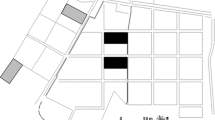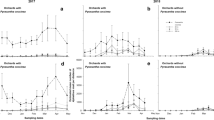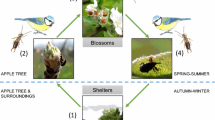Abstract
Bioindicators that reflect the level of chemical control have not been developed for use in apple orchards in Japan. In Japan, many carabid beetles and spiders are beneficial predators of a wide range of agricultural pest insects. In apple orchards, spider numbers are reflective of the level of control pressure, but there is no information on carabid beetles. To establish whether carabid beetles could indeed be useful bioindicators, the number of carabid beetles and spiders in six apple orchards (A–F) under different levels of control pressure was investigated in Akita prefecture, northern Japan, in 2008 and 2009. The negative impact on beneficial arthropods was assumed to decrease in the order of pyrethroids (A) > organophosphates (B) > neonicotinoids (C) > insect growth regulators (D) > fungicides only (E) > no spraying (F). Sprays were applied at 2-week intervals from mid-May to early August. Twenty species of carabid beetles were found in orchard F; about 50% of adults were Anisodactylus punctatipennis, and 30–40% were Amara chalcites. The number of Am. chalcites significantly decreased with increasing control pressure: (A–C) < (E, F) in 2008, (A–E) < F in 2009, and (A, B) < E in 2009. Most spiders collected were juvenile Tetragnathidae and Araneidae. The numbers of spiders and Am. chalcites adults were significantly highly correlated at each control pressure in both years. Thus, it was considered that only Am. chalcites adults can be used as bioindicators reflecting the control pressure in apple orchards in northern Japan, whereas the main diet of this species is probably C3 plants.



Similar content being viewed by others
References
Amalin DM, Pena JE, Yu SJ, McSorley R (2000) Selective toxicity of some pesticides to Hibana velox (Araneae: Anyphaenidae), a predator of citrus leafminer. Fla Entomol 83:254–262
Bogya S, Markó V, Szinetár CS (2000) Effect of pest management system on foliage- and grass-dwelling spider communities in an apple orchard in Hungary. Int J Pest Manag 46:241–250
Bonn A, Gaston KJ (2005) Capturing biodiversity: selecting priority area for conservation using different criteria. Biodivers Conserv 14:1083–1100
Bostanian NJ, Dondale CD, Binns MR, Pitre D (1984) Effects of pesticide use on spiders (Araneae) in Quebec apple orchards. Can Entomol 116:663–675
Cárdenas M, Ruano F, Garcia P, Pascual F, Campos M (2006) Impact of agricultural management on spider populations in the canopy of olive trees. Biol Control 38:188–195
Funayama K (1999) Studies on control and management of apple rust mite, Aculus schlechtendali (Nalepa). II: Chemical applications for protection of apple rust mites and native predatory mites in apple orchards using synthetic sex pheromone. Bull Akita Fruit Tree Exp Stn 26:1–13 (in Japanese with English summary)
Hamasaki K (2007) Biodiversity conservation in rice paddy field. Plant Prot 61:604–610 (in Japanese)
Hector A, Bagchi R (2007) Biodiversity and ecosystem multifunctionality. Nature 448:188–191
Hirai K (2009) Functional agrobiodiversity and plantprotection in agri-enviromental scheme. Plant Prot 63:646–650 (in Japanese)
Humphrey JW (2005) Benefits to biodiversity from developing old-growth conditions in British upland spruce plantations: a review and recommendations. Forestry 78:33–53
Ikeda H, Kubota K, Kagawa A, Sota T (2010) Diverse diet compositions among ground beetle species revealed by mixing model analysis of stable isotope ratios. Ecol Entomol 35:307–316
Kerr G (1999) The use of silvicultural systems to enhance the biological diversity of plantation forests in Britain. Forestry 72:191–205
Kosugi Y (2003) Toxicity of pesticides on two species of spiders, Trachelus japonica and Philodromus subaureoles. Bull Shizuoka Tea Exp Stn 24:17–24 (in Japanese with English summary)
Maleque MA, Maeto K, Ishii HT (2009) Arthropods as bioindicators of sustainable forest management, with a focus on plantation forests. Appl Entomol Zool 44:1–11
Markó V, Keresztes B, Fountain MT, Cross JV (2009) Prey availability, pesticides and the abundance of orchard spider communities. Biol Control 48:115–124
Masuda T (2009) Effect of living mulch on oviposition of small white pieris rapae crurcivora and occurrence of insect pests in cabbage fields. Annu Rep Plant Prot North Jpn 60:208–211 (in Japanese)
Masuda T, Miyata M (2008) Effect of cover cropping on occurrence of insect pests in cabbage fields. Annu Rep Plant Prot North Jpn 59:153–157 (in Japanese)
Miliczky ER, Calkins CO, Horton DR (2000) Spider abundance and diversity in apple orchards under three insect pest management programmes in Washington State, USA. Agric For Entomol 2:203–215
Mizukoshi T (2000) Damage of carabid beetles to spring seeding radish in central Oshima, Hokkaido. IV. Toxic effect of four foliar spray insecticides against three species of carabid beetle adults. Annu Rep Plant Prot North Jpn 51:227–230 (in Japanese with English summary)
Mizukoshi T (2005) Dispersion range of carabid beetle adults on bare ground. Annu Rep Plant Prot North Jpn 56:175–177 (in Japanese with English summary)
Nakamura Y, Ide T (1992) Influence of chemical sprays on spiders in tea fields and predatory behavior of Trachelus japonica and Oxyopes sertatus. Bull Shizuoka Tea Exp Stn 16:43–49 (in Japanese with English summary)
Okazaki K, Arakawa A, Sato R (2000) Control of major lepidopterous insect pests by the multiple mating disruptor in apple orchards. 3. Parasitoids of the summer-fruit tortrix moth, Adoxophyes orana fasciata and annual fluctuation. Annu Rep Plant Prot North Jpn 51:245–255 (in Japanese)
Pekár S (1999) Effect of IPM practices and conventional spraying on spider population dynamics in an apple orchard. Agric Ecosyst Environ 73:155–166
Suenaga H, Hamamura T (2001) Occurrence of carabid beetles (Coleoptera: Carabidae) in cabbage fields and their possible impact on lepidopteran pests. Appl Entomol Zool 36:151–160
Suzuki Y (2007) Agriculture contributing to the conservation of biodiversity. Plant Prot 61:597–598 (in Japanese)
Tanaka K (1985) Carabidae (Zabrinae). In: Ueno S, Kurosawa R, Sato M (eds) The Coleoptera of Japan in color, vol II. Hoikusha, Osaka, pp 135–136 (in Japanese)
Tanaka K, Kazano H, Endo S (1990) Insecticide susceptibility of three spiders in paddy field. Proc Assoc Plant Prot Kyushu 36:97–99 (in Japanese with English summary)
Villanueva RT, Walgenbach JF (2005) Development, oviposition, and mortality of Neoseiulus fallacis (Acari: Phytoseiidae) in response to reduced-risk insecticides. J Econ Entomol 98:2114–2120
Yano K, Yahiro K, Uwada M (1989) Species composition and seasonal abundance of ground beetles (Cpleoptera) in a Vineyard. Bull Fac Agric Yamaguchi Univ 37:1–14
Acknowledgments
I thank B. Short of the Appalachian Fruit Research Station of the Agricultural Research Service of USDA for proofreading the manuscript; M. Toyama of the National Institute of Fruit Tree Science for his helpful suggestions; H. Kikuchi of the Agricultural Experiment Station, Akita Prefectural Agriculture, Forestry and Fisheries Research Center for his help in identifying adult Carabidae; A. Tanikawa of the Faculty of Agriculture, University of Tokyo, for his help in identifying spiders; and the staff of the Fruit-Tree Experiment Station, Akita Prefectural Agriculture, Forestry and Fisheries Research Center, for their assistance with the field work. This work was supported by “Selection of Functional Biodiversity Indicators and Development of Assessment Methods 1122” of the Ministry of Agriculture, Forestry and Fisheries of Japan.
Author information
Authors and Affiliations
Corresponding author
Rights and permissions
About this article
Cite this article
Funayama, K. Influence of pest control pressure on occurrence of ground beetles (Coleoptera: Carabidae) in apple orchards. Appl Entomol Zool 46, 103–110 (2011). https://doi.org/10.1007/s13355-010-0015-9
Received:
Accepted:
Published:
Issue Date:
DOI: https://doi.org/10.1007/s13355-010-0015-9




